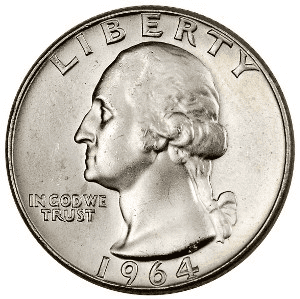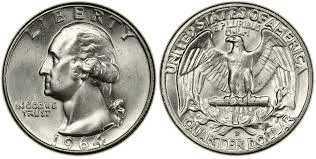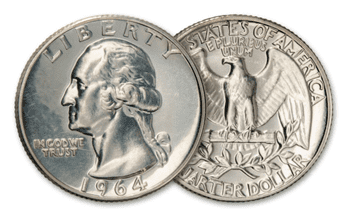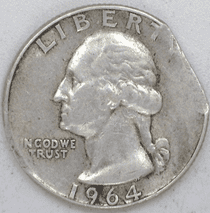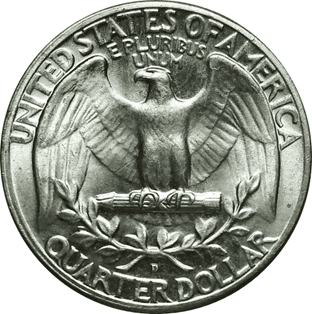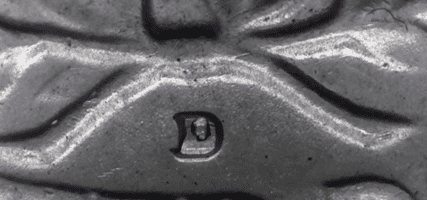The 1964 Quarter is special because it was the last year that the US mint minted quarters in a silver/copper composition, switching to a much more affordable and plentiful copper composition from 1965 onwards. This was because the US mint found that their silver reserves had dropped dramatically low as the value of silver increased, leading to people hoarding their silver quarters due to their metal value which exceeded the face value of the coin.
All quarter coins manufactured between 1932 and 1964 contain 90% silver and 10% copper. They are 6.25 grammes in weight and contained 0.1808 troy ounces of pure silver. After this date, all Washington Quarter coins are composed of a cladding of copper and nickel (91.67 % copper and 8.33% nickel).
Contents
1964 Quarter Design Features
The 1964 Quarter has some distinguishable design features, which are as follows:
Portrait
The portrait of George Washington, the first president of the United States of America, is featured on the current regular issue in circulation and the 1964 coin.
Obverse (Head) Characteristics
The portrait of President George Washington on the obverse face, as seen when held in the palms, is facing left. The sculptor for the coin John Flanagan was inspired by a portrait of George Washington created by another artist in 1786. The word LIBERTY appears above his head, while the minting date is printed slightly to the left, below his head. ‘IN GOD WE TRUST,’ which appears on the left-hand side, below the president’s chin, is also written on the obverse.
Reverse (Tail) Characteristics
A bald eagle with long, spread wings sits in the centre of the coin’s reverse. The eagle is perched atop a bundle of arrows, which is surrounded by olive sprays. The words ‘UNITED STATES OF AMERICA’ and the motto ‘E PLURIBUS UNUM’ are displayed above the eagle. The word ‘QUARTER DOLLAR’ appears beneath the eagle, indicating the coin’s face value.
Edges
The 1964 Quarter has a ridged edge comprised of 119 reeds.
Slogans
Multiple slogans are written on the 1964 Quarter. Their meanings are as follows:
- IN GOD WE TRUST
The slogan is a well-known statement on United States of America coins. It arose as a result of a rise in religious sentiments among Americans throughout the civil wars. Since July 1, 1908, the phrase has appeared on all silver, gold, half-dollar, and quarter-dollar coins. - UNUM PLURIBUS
The motto is a Latin phrase meaning “out of many, one. In 1776, it was chosen as the country’s official motto. According to Harvard research, it denotes the country’s ability to unite multiple states into a single nation. This was seen as a great accomplishment, achieved by the cooperation of many people of various beliefs, backgrounds, skin colours, and values. - LIBERTY
One of the most essential ideals and founding principles of the United States of America is liberty. Liberty is a fictional female figure that the United States has adopted as a global symbol of liberty. One side of a US coin should always bear the inscription LIBERTY, according to the US Money Reserve.
How Can You Tell If A 1964 Quarter Is Silver?
As a general rule of thumb, you can tell if your quarter is silver by checking the date. If dated before 1965 then your coin is silver. However, you can also make sure by weighing the coin. Silver quarters weigh 6.25g, while non-silver quarters weigh less at 5.76g.
1964 Quarter Series
1) 1964 Quarter With No Mint Mark
Year: 1964
Face Value: $0.25
Composition: 90% silver, 10% copper
Silver Weight: 18084 oz.
Total Weight: 6.25g
Diameter: 24.26 mm (0.955 in)
Thickness: 1.75 mm (0.069 in)
Edge: 119 Reeds
Minted in: Philadelphia
Quantity Minted: 560,390,585

photo source: www.silverrecyclers.com
2) 1964 D Quarter
Year: 1964
Face Value: $0.25
Composition: 90% silver, 10% copper
Silver Weight: 18084 oz.
Total Weight: 6.25g
Diameter: 24.26 mm (0.955 in)
Thickness: 1.75 mm (0.069 in)
Edge: 119 Reeds
Minted in: Denver
Quantity Minted: 704,135,528

photo source: www.pcgs.com
3) 1964 Proof Quarter
Year: 1964
Face Value: $0.25
Composition: 90% silver, 10% copper
Silver Weight: 18084 oz.
Total Weight: 6.25g
Diameter: 24.26 mm (0.955 in)
Thickness: 1.75 mm (0.069 in)
Edge: 119 Reeds
Minted in: Philadelphia
Quantity Minted: 3,950,762

photo source: www.govmint.com
List of Errors
1964 Washington Quarter Straight Clip

photo source: www.goodoletom.com
The Blakesley effect, where the opposing edge of the coin displays weakness around the rim because the metal did not fully fill the dies and collar, causes this form of clipped planchet.
Rare 1964 Quarter Errors include:
- 1964-D Washington, Reverse of 1965 [Also called Type C Reverse, or (RDV-003,)]
- 1964-D RPM Variety D Over D Mintmark
- 1964-D doubled die
Are There Any Rare 1964 Quarters?
The rarest examples of 1964 Quarters are those with errors that were briefly listed above. Let’s take a look at these in closer detail.
1) 1964-D Washington, Reverse of 1965

photo source: markedmoney.tech
Also known as Type C Reverse, or (RDV-003), this variant of the 1964 quarter is actually an error made during the transition between silver-based coins (1964) and copper/nickel coins (1965). In this error, the silver 1964 coin has been struck using a die intended for the copper/nickel coins.
Copper and silver have different densities, which is why new dies were needed. Because of this, the Type C Reverse error appears far more detailed than its other counterpart, which is particularly noticeable on the foliage of the coin.
It is unclear how many of these error coins were created, but examples of this coin can reach upwards of $200.
2) 1964-D RPM Variety D Over D Mintmark

photo source: markedmoney.tech
A repunched mintmark happens when the letter punch that is used to punch the mintmark into the die leaves two or more offset impressions. The impressions overlap and overall the mint mark, in this case, a ‘D’ looks like it has been pressed far more deeply into the coin.
A completely separate secondary mintmark is a rarity and would command a higher price. Depending on the nature of the repunch, these coins can be worth upwards of $50.
What Is The Value Of A 1964 Silver Quarter?
Because of its high silver content, 1964 Quarters are worth far more than their face value (25c); in fact 16x more. The melt value for these coins currently sits at around $4.
Outside of its melt value, the value of the different types of 1964 Quarter are as follows:
| Coin | Mintage | Value (Dependent on Grade) |
| 1964 No Mintmark (Philadelphia) | 560,390,585 | $4+ |
| 1964-D (Denver) | 704,135,528 | $4+ |
| 1964 Proof | 3,950,762 | $11+ |
Factors that affect the value of coins are mostly the condition of the coin in question, the composition of the coin (i.e silver or nickel), and the scarcity of the coin. In the next section, we’ll explore how the grading system work.
How Coins are Graded
The Sheldon Scale is used by numismatists to provide a numerical value to coins. The Sheldon Scale goes from poor (P-1) to perfect mint state (P-1) (MS-70). Coins were originally evaluated using words to reflect their condition (Good, Fair, Excellent, Etc.). Unfortunately, coin collectors and dealers had different ideas about what each of these terms represent.
Professional numismatists joined together in the 1970s and established CoinGrading standards. These numismatists now assign grades at key places on the seventy-point scale, using the most regularly utilized numeric points in conjunction with the original adjective grade. The following are the most common coin grades:
- (P-1) Poor – Indistinguishable and probably damaged; if used, must have a date and mintmark; otherwise, rather battered.
- (FR-2) Fair – Nearly smooth, but without the damage that a coin graded Poor often possesses. The coin must have enough detail to be identified.
- (G-4) Fair – Inscriptions have merged into the rims in some areas, and important elements have been mostly erased.
- (VG-8) Very Good- A little weathered, but all of the primary design elements are visible, albeit faintly. There is little if any, central detail left.
- (F-12) Good – The item is very worn, yet the wear is even, and the overall design details stand out clearly. Rims are almost completely isolated from the field.
- (VF-20) Very Fine – Moderately weathered, with some finer features still visible. The motto or all letters of LIBERTY are readable. Both sides of the coin have entire rims that are separated from the field.
- (EF-40) Extremely Fine – Gently used; all gadgets are visible, and the most important ones are bold. The finer details are bold and clear, however, light wear may be seen.
- (AU-50) Uncirculated – Slight evidence of wear on the coin’s design’s high points; may have contact marks; eye appeal should be adequate.
- (AU-58) Uncirculated Choice – Slight traces of wear, no severe contact marks, almost full mint shine, and great eye appeal.
- (MS-60) Mint State Basal – Strictly uncirculated; no indication of wear on the coin’s highest points, but an unsightly coin with reduced luster, visible contact marks, hairlines, and other flaws.
- (MS-63) Mint State Acceptable – Uncirculated, but with contact scratches and nicks, little reduced shine, but otherwise appealing appearance. The strike is weak to average.
- (MS-65) Mint State Choice – Uncirculated with great mint shine, very little contact blemishes, and exceptional eye appeal. The strike is unusually severe.
- (MS-68) Mint State Premium Quality – Uncirculated with superb luster, no obvious contact marks to the naked eye, and exceptional eye appeal. The strike is quick and appealing.
- (MS-69) Almost Perfect Mint State – Uncirculated with perfect brilliance, a sharp and appealing strike, and extremely good eye appeal. A near-perfect coin with minor imperfections in the planchet, strike, and contact markings (seen only under 8x magnification).
- (MS-70) Mint State Perfect – Under 8x magnification, there are no tiny imperfections discernible; the strike is crisp, and the coin is perfectly centered on a beautiful planchet. Rarely seen on a coin, this coin is bright and whole, with original luster and exceptional eye appeal.
Where To Buy Or Sell 1964 Quarters?
There are a variety of options when it comes to buying and selling 1964 quarters, such as eBay, currency converters, estate sales, online auctions, specialist coin dealers, and even to scrap merchants for their intrinsic metal value.
1964 Events
To begin with, the Warren Commission report on President John F. Kennedy’s assassination determines that Lee Harvey Oswald acted alone, finally putting the public’s mind at peace.
President Lyndon B. Johnson signs the Civil Rights Act of 1964 into law, and Dr Martin Luther King, Jr. is awarded the Nobel Peace Prize.
Important national events such as those listed above can add sentimental value to coins from this year, and aside from any monetary value found in the coin, can be enough reason for individuals to collect coins, which is the beauty of the hobby.
FAQs
What is the value of a 1964 Washington quarter?
Because it is made of mostly silver, the 1964 Washington Quarter has a metal value of at least $4.
What is the value of a 1964 Canadian quarter?
Like the Washington Quarter, the Canadian Quarter has a metal value of at least $4.
What makes a 1964 quarter valuable?
The 1964 Quarter is special because it was the last year that the US mint minted quarters in a silver/copper composition.
How many 1964 quarters make an ounce of silver?
A quarter ounce of pure silver is contained in each silver quarter. This equates to around 5.5 silver quarters per ounce of silver. We may round up and say it takes 6 silver quarters to make a troy ounce because you can’t have half of a coin.
What does it mean if a quarter has no mint mark?
Quarters without mint marks were minted in Philadelphia. Coins manufactured here are never given a mint mark unlike coins minted in Denver (D) or San Francisco (S).

